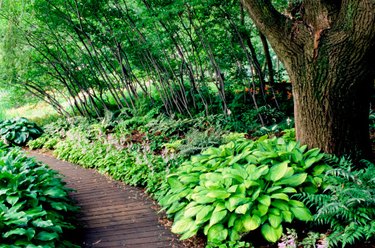Things You'll Need
Garden spade
Garden shovel
Work gloves
Well-rotted manure, shredded leaves or compost
Measuring tape
Garden gloves
Trowel
Potted hostas suited to your planting site
Daffodil and tulip bulbs
Shade-adapted summer bedding plants
Fertilizer, 10-10-10
Pine straw

Gardeners often plant hostas as trouble-free ground cover plants for dappled shade because their large leaves effectively cover the underlying soil. But they can be so much more than ground cover. Specimen and border-type hostas are ideal companions for shade-adapted annual and perennial flowers. Hosta plants vary greatly in size and leaf color, pattern, shape and texture. Most hostas also produce stalks of lily-shaped white or lavender flowers in summer. Plan your hosta flower bed with both foliage and flower characteristics in mind.
Step 1
Locate a shaded site for your hosta bed. Assess how much light plants will receive during the growing season. Also consider soil moisture levels, because hostas require evenly moist soil. Provide a water source if the bed will need supplemental watering.
Video of the Day
Step 2
Purchase hostas that will thrive under your shade conditions. Deeper shade suits hostas with deep blue-green foliage, such as 'Blue Angel,' to maintain the waxy leaf coating responsible for their bluish color. Chartreuse or yellow-green hostas, including fragrant cultivars 'August Moon' and 'Sum and Substance', brighten when they are grown in partial sun.
Step 3
Spade and turn topsoil to a depth of 12 to 16 inches. Add 6 inches of rich organic matter, using the shovel to dig it in and mix it thoroughly with the soil. Measure and mark each planting hole, allocating space according to the mature size of each hosta. Place dwarf and small hostas close to bed borders or in front of larger hostas.
Step 4
Dig each planting hole about 12 inches deep and one and a half times the expected width of the mature plant, because hosta roots grow horizontally. Remove each plant from its container. Loosen roots, shake off excess soil and place the hosta in its hole. Make sure leaves and roots meet at ground level as you fill the hole half full with soil then water. Finish filling the planting hole and water thoroughly.
Step 5
Mulch the bed with 2 to 4 inches of pine straw to suppress weeds and conserve moisture. Make sure hostas receive at least 1 inch of water per week, whether from rain or irrigation. Deep regular watering supports healthy root development.
Step 6
Plant bulbs such as daffodils and tulips and early blooming perennials to enliven the flower bed as hosta leaves emerge in spring. Choose shade-tolerant summer flowering plants including feverfew (Tanaceteum parthenium), impatiens, monkey flower (Mimulus) and cardinal flower (Lobelia cardinalis) to border walkways and fill in gaps.
Tip
Apply balanced fertilizer in spring as plants emerge, again six weeks later and a final time in midsummer.
Browned leaves or leaf margins on a hosta signify sunscald, a problem that can be solved by additional watering or by moving the affected plant to a shadier spot.
Control slugs and snails, which will shred or perforate hosta leaves. Non-toxic bait products containing iron phosphate, such as Sluggo, are ideal.
Video of the Day